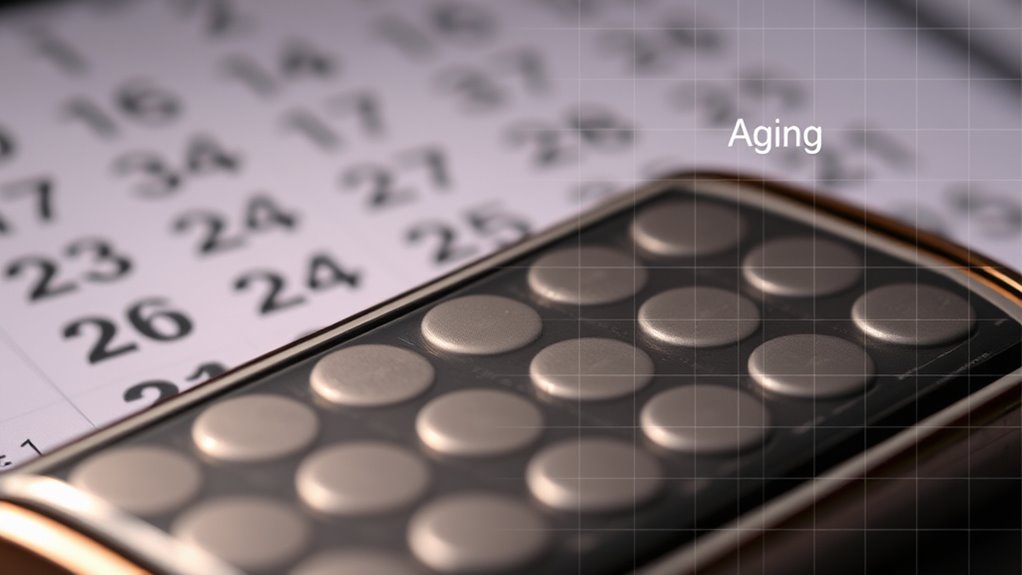Both calendar aging and cycle aging slowly wear out your battery, but they affect it differently. Calendar aging happens over time even when you’re not using it, especially at high temperatures. Cycle aging results from repeated charges and discharges, with frequent or deep cycling speeding up capacity loss. Understanding which process is more responsible can help you extend your battery’s life. Keep going to discover how to best manage these aging effects and protect your pack.
Key Takeaways
- Calendar aging causes capacity loss over time even when the battery is unused, while cycle aging results from repeated charge/discharge cycles.
- High temperatures accelerate calendar aging by speeding up chemical reactions inside the battery.
- Deep discharges and fast charging mainly worsen cycle aging, leading to faster capacity fade during use.
- Proper storage in cool, dry environments slows calendar aging, extending battery lifespan regardless of usage.
- Both aging processes contribute to capacity loss, but managing usage and storage can mitigate their combined effects.

Understanding how batteries degrade over time is essential for optimizing their lifespan and performance. When it comes to battery aging, two main processes are at play: calendar aging and cycle aging. Each affects your battery differently, and knowing the distinction helps you better care for your pack.
Calendar aging refers to the natural deterioration that occurs simply as your battery sits unused over time. Regardless of whether you’re actively using or storing the battery, chemical changes happen within the cells. These changes are heavily influenced by factors like temperature, humidity, and the battery’s chemistry. For example, high temperatures accelerate chemical reactions, speeding up capacity loss even if the battery isn’t being cycled. Understanding this, you realize that proper storage—keeping your pack in a cool, dry place—can markedly slow down calendar aging.
Calendar aging causes capacity loss over time, even when the battery isn’t used, especially at high temperatures.
Battery chemistry plays an indispensable role here because different chemistries age at different rates. Lithium-ion batteries, common in everything from smartphones to EVs, are particularly susceptible to calendar aging. The electrolyte and electrode materials gradually degrade, leading to capacity fade over time. Manufacturing defects can also speed up this process. Flaws like poorly applied separator layers, impurities in the electrolyte, or inconsistent electrode coatings create weak points inside the cell. These defects can cause uneven degradation, leading to faster capacity loss and reduced lifespan. So, when you buy a new battery, quality control during manufacturing is critical—defects can cause your pack to age prematurely, regardless of usage. Additionally, the internal structure of the battery influences how well it withstands aging processes.
Cycle aging, on the other hand, occurs when you repeatedly charge and discharge your battery. Every charge cycle causes a small amount of wear, gradually degrading the electrodes and electrolyte. The more frequently you cycle your pack, the more you accelerate this form of aging. High charge rates, deep discharges, and fast charging all exacerbate cycle aging, which is why you might notice your battery’s capacity diminishing faster if you regularly drain it to very low levels or charge it rapidly. Proper management techniques, like avoiding full discharges and limiting fast charging, can help mitigate cycle aging.
Frequently Asked Questions
How Can I Detect Early Signs of Calendar Aging in My Battery?
To detect early signs of calendar aging in your battery, monitor battery degradation and aging indicators regularly. Look for reduced capacity, increased internal resistance, or faster self-discharge rates, even when not in use. Use diagnostic tools or apps to check voltage and health reports. If you notice these signs, it indicates your battery is aging prematurely, and you should consider replacing it to maintain ideal performance and longevity.
What Are the Best Practices to Minimize Cycle Aging?
To minimize cycle aging, focus on your charging habits and storage conditions. Avoid frequent full charges or deep discharges, as they accelerate cycle wear. Instead, keep your battery between 20-80% when possible. Store it in a cool, dry place, away from extreme temperatures, to reduce stress. Using smart chargers and limiting high-current fast charging also helps preserve battery health, extending its lifespan and performance.
Do Certain Battery Chemistries Age Faster Overall?
Think of your battery chemistry as a race car’s engine — some models are built for speed, others for endurance. Certain chemistries age faster overall, meaning they degrade quicker over time. You’ll find that lithium-ion variants, for instance, often have a faster aging speed than newer chemistries like solid-state batteries. So, choosing the right chemistry directly impacts how long your pack lasts and how quickly it wears out.
How Does Temperature Influence Calendar and Cycle Aging Differently?
Temperature critically impacts both calendar and cycle aging through thermal effects. Higher temperatures accelerate chemical reactions, causing faster capacity loss in your battery. Proper temperature management helps slow this aging process. For cycle aging, heat worsens electrode degradation during charge-discharge cycles. For calendar aging, elevated temperatures hasten aging even when the battery isn’t in use. Keeping your pack within ideal temperature ranges is key to extending its lifespan and maintaining performance over time.
Can Cycling Patterns Reverse or Slow Down Aging Effects?
You might wonder if cycling patterns can reverse or slow down aging effects. While they can’t fully reverse aging, effective cycling strategies can help mitigate cycle aging, preserving your battery’s capacity longer. Regular battery rejuvenation through controlled charging and discharging reduces stress and degradation. By adopting proper cycling habits, you can extend your pack’s lifespan and maintain performance, even if calendar aging continues gradually over time.
Conclusion
Understanding the difference between calendar and cycle aging helps you better care for your battery. Did you know that calendar aging accounts for up to 80% of battery capacity loss over five years? This means even if you rarely use your pack, it still degrades over time. So, whether you’re storing or actively cycling your battery, staying aware of both aging types guarantees you maximize its lifespan and performance. Don’t overlook these factors—your battery’s health depends on it.










